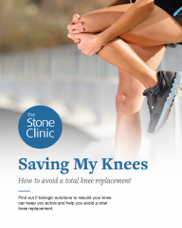What’s Hot & What’s Not in Knee Surgery: A Few of the Highlights
Stem cells are both in and out. It was once thought that if these cells were injected into joints, they would turn into cartilage. Two problems arose. First, patients (unless they are infants) have very few stem cells left. Second, the injected cells died after releasing their instructional growth factors, never turning into cartilage. But what we have learned is that an increasing number of concentrated growth factors, immune stimulants, and even some drugs can induce the migration of the body’s own progenitor cells—some of them stem cells—cells that direct healing—to the injured area. These cells then optimize the environment around the injury to effect healing.

PRP and growth factors are still in. PRP is a concentrate formed from platelets in the blood. The platelets have vesicles that contain vast amounts of varied growth (and other) factors that modulate the healing area. Formulations with and without white cells may have different effects on the tissues. Growth factors from fat cells, and bone marrow concentrates are all potent. There’s no clear superiority of one over the other at this time. And none have definitively helped regenerate true articular cartilage or any other tissue yet. But they do optimize the healing once an injury or surgical repair has occurred.
Despite evidence that removing even a small portion of the meniscus leads to arthritis, more than 90% of meniscus treatments are partial removals called meniscectomies. The insurance companies, by paying only for tissue removal, essentially kick the can down the road where some other insurance company will have to pay for a joint replacement. But more advanced techniques of meniscus repair, regeneration, and replacement are now making the procedures easier and faster—and surgeons are finally using them. Still, there remains only one scaffold to re-grow the meniscus—the collagen meniscus implant (CMI)—but it is not being marketed or used widely enough yet.
Meniscus replacement, or transplantation, has been shown in long-term studies to reduce pain and improve function in both pristine young knees and in older arthritic knees. But very few centers are deploying them regularly, as the surgical technique is difficult and time-consuming.
Articular cartilage repair with microfracture has fallen out of favor, as the results don’t hold up in athletes for more than a few years. One scaffold called MACI has been approved in the US to hold cells and growth factors at the site of chondral lesions. The articular cartilage paste grafting technique that we pioneered 30 years ago has shown long-term effective results and is gaining traction with podium presentations at many major orthopaedic meetings this year. It still lacks commercial support, since it is free (i.e., without implants to charge for). Thus it will likely lag behind in surgeon uptake until a wide clinical trial is performed and more surgeons are trained.
ACL tears are still occurring at a rate of about 300,000 per year and most are reconstructed with the patients’ own tissues—though high-quality allografts are more widely available now. These have the same outcomes in some surgeons’ hands and avoid the second-site surgery pain and weakness that the harvest of the patellar tendon or hamstrings produces. It remains shocking to me that in the 21st century we are still robbing one part of the body to rebuild another. No new artificial ligaments have come on the market, though there are several supporting scaffolds or bands being used (despite a lack of outcome data). Pig tissue we also developed is approved in Europe but not yet commercialized. The arthritis rate after ACL surgery is reported at 50% after 10 years, with the failure rate in young people at 30%, so there is a lot of room for improvement. Adding growth factors and progenitor cells should help, but data is pending.
Robotic surgery has permitted highly accurate outpatient partial- and total-knee replacements, and younger people are choosing these options. A dramatic shift to cementless knee replacement devices amongst the robotic surgeons is occurring. When these were tried in the past, the pain and failure rates were too high as gaps were present between the implant and the bone. The high accuracy of the robotic saws now permits near-perfect interfaces, thereby eliminating the need for cement. No cement may mean less chance of loosening, allowing patients to return to sports. This has major implications for patients, surgeons, and quality of life.
Real-time outcomes data is rapidly entering the field, thanks to the advent of personal fitness devices, ubiquitous electronic medical records, and artificial intelligence-driven data mining programs. Since nearly all patients now have smartphones, apps that can collect outcome data can soon be installed on those phones. They will monitor in real-time the progress or problems with any medical or surgical intervention, collecting much valuable information over long spans of time.
What’s hottest in medicine is technology and progress. What is not is a head-in-the-sand approach, repeating the same procedures with average or unknown outcomes. In my personal view, it is no longer acceptable for a doctor to do something to or put something in a patient that they do not know or want to study the outcome. The question, “Doc, how do you know this works?” will soon be answered with, “Here is my data.”


